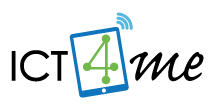Math in ICT4me
Along with singing and drawing, math is one of the more socially excusable can'ts: "I can't or could never do math." Kids often get turned off of math in late elementary and early middle school years. As the math gets harder, it becomes harder to re-engage youth in wanting to put in the effort to learn math. However, aside from the intellectual benefit of understanding the mathematical structures of the world, students that graduate with more and higher level math classes have better college opportunities and can choose from a wide variety of careers. For example, even at a community college, Computer Science course requirements typically include Analysis of Algorithms, Discrete Mathematics (which includes topics like graph theory and combinatorics), Calculus and Probability / Statistics.
The ICT4me solution to keeping youth engaged in mathematics and to see the pathways through high school is to find meaningful, fun, and creative ways of learning mathematics. In ICT4me, participants engage in atypical math activities that directly relate to the ICT content, such as exploring graph theory to understand networks, finding the number of color combinations available for a website, and using logic models and algorithmic thinking to program a computer game. These activities are meant to give youth exposure and practice with higher level math than they normally get at school.
ICT4me math also addresses specific middle school mathematics concepts, such as these outlined in the NCTM Standards and Principles (2001):
- Algebra: represent patterns in tables, with graphs and with symbolic expressions.
- Number: use exponential and scientific notation.
- Data and probability: use tree diagrams or other methods to enumerate a "sample space."
- Geometry: use visual tools such as networks to solve problems.
- A "mathematical disposition" toward problem solving requires analyzing given information, drawing on specific strategies, and having the ability to monitor and adjust strategy use.
- Mathematical reasoning includes making conjectures and using deductive reasoning to prove or disprove them and can be applied to computer science strategies such as troubleshooting algorithms.
- Mathematical communications and representations involve effective use of diagrams, equations, and other mathematical symbols. Developing the skills to communicate mathematically can make collaborative design work easier and more productive.
Tips on leading Math Activities
- Math activities are meant to be fun, and attitudes matter. If you are nervous yourself or feel an intense dislike for math, youth will pick that up even if you don't say anything.
- Before leading the activity, try it out yourself. Make sure you have made sense of the activity, your process, and alternative solutions.
- Find a math mentor or counselor who can help you with understanding the mathematics and the multiple solutions offered. Don't be surprised to find that most people don't really know this stuff either!
- Help youth discover the math: Ask questions and offer hints, but don't give away solutions – the fun part is in the process of youth discovering the solutions.
Math Activities in the curriculum
Math is everywhere in ICT4me. You will find NCTM's process standards everywhere: problem solving, communicating about math (and computer science), making connections across representations. Algorithmic thinking and logic are fundamental ways of approaching many ICT tasks. In addition, each unit contains one or more specific math activities. Here they are:
Unit 1, Week 4. Things That Fly. (.pdf, 179 KB) Youth explore the design (materials and structure) of flying toys such as frisbees, aerobies, and boomerangs in order to propose and then construct the best design. Youth engage in researching, prototyping, and building their designs.
Unit 2, Week 3. Internet Safety & Design. (.pdf, 168 KB) Youth explore the structure of the Internet, Internet elements, and Internet safety, such as understanding privacy and digital footprints. Youth also, experience communication tools and strategies for comparing their features.
Unit 2, Week 6. Getting to Graphs. (.pdf, 1.5 MB) Youth use graph theory to describe and plan connections among their Clubhouses. Youth reflect on the role of mathematics in technology and their lives.
Unit 2, Week 10. Getting to Your Blog. (.pdf, 130 KB) Youth use algorithmic thinking to determine the best plan for using a series of blogs as communication tools and comment on each others' blogs.
Unit 3, Day 6. Color Your World. (.pdf, 345 KB) Youth engage in a calculate how many color combinations they can use on their pages, connecting ICT and math. Youth continue to work on their website.
Unit 4, Week 3 . Network Layouts (aka Topologies). (.pdf, 690 KB) Youth play graph games and learn about basic network topologies and their properties.
Unit 5, Week 2 . Learning Stagecast with Pond Life. (.pdf, 3 MB) Youth use coordinate geometry to understand how engineers and designers plan movement and location of characters.
Managers/Coordinators/Directors
 |
© 2013-2016 SRI International. 333 Ravenswood Ave. Menlo Park, CA 94205. Produced by the Center for Technology in Learning at SRI International with support from the National Science Foundation under Grant Nos. 1339181, 1232461, and 0524762. Any opinions, findings, conclusions, or recommendations expressed are those of the authors and do not necessarily reflect the views of the National Science Foundation. |

|

